
A seat is a place to sit. The term may encompass additional features, such as back, armrest, head restraint but also headquarters in a wider sense.

Furniture refers to objects intended to support various human activities such as seating, eating (tables), storing items, working, and sleeping. Furniture is also used to hold objects at a convenient height for work, or to store things. Furniture can be a product of design and can be considered a form of decorative art. In addition to furniture's functional role, it can serve a symbolic or religious purpose. It can be made from a vast multitude of materials, including metal, plastic, and wood. Furniture can be made using a variety of woodworking joints which often reflects the local culture.
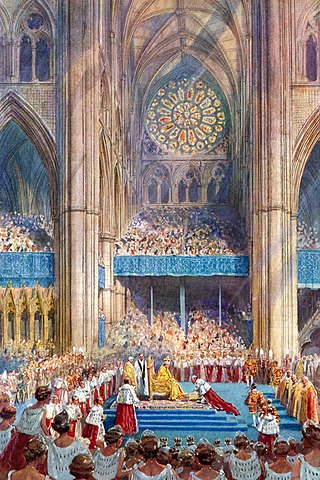
The coronation of the monarch of the United Kingdom is an initiation ceremony in which they are formally invested with regalia and crowned at Westminster Abbey. It corresponds to the coronations that formerly took place in other European monarchies, which have all abandoned coronations in favour of inauguration or enthronement ceremonies. A coronation is a symbolic formality and does not signify the official beginning of the monarch's reign; de jure and de facto his or her reign commences from the moment of the preceding monarch's death or abdication, maintaining legal continuity of the monarchy.

Knole is a country house and former archbishop's palace owned by the National Trust. It is situated within Knole Park, a 1,000-acre (400-hectare) park located immediately to the south-east of Sevenoaks in west Kent. The house ranks in the top five of England's largest houses, under any measure used, occupying a total of four acres.

A couch, also known as a sofa, settee, chesterfield, or davenport, is a cushioned item of furniture for seating multiple people. It is commonly found in the form of a bench with upholstered armrests and is often fitted with springs and tailored cushion and pillows. Although a couch is used primarily for seating, it may be used for sleeping. In homes, couches are normally put in the family room, living room, den, or lounge. They are sometimes also found in non-residential settings such as hotels, lobbies of commercial offices, waiting rooms, and bars. Couches can also vary in size, color, and design.
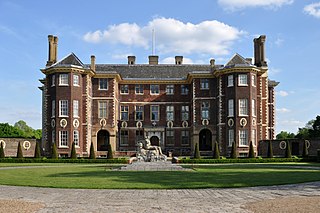
Ham House is a 17th-century house set in formal gardens on the bank of the River Thames in Ham, south of Richmond in the London Borough of Richmond upon Thames. The original house was completed in 1610 by Thomas Vavasour, an Elizabethan courtier and Knight Marshal to James I. It was then leased, and later bought, by William Murray, a close friend and supporter of Charles I. The English Civil War saw the house and much of the estate sequestrated, but Murray's wife Katherine regained them on payment of a fine. During the Protectorate his daughter Elizabeth, Countess of Dysart on her father's death in 1655, successfully navigated the prevailing anti-royalist sentiment and retained control of the estate.
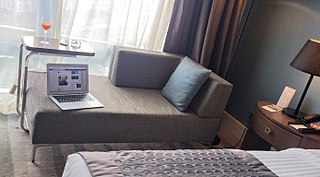
A chaise longue is an upholstered sofa in the shape of a chair that is long enough to support the legs of the sitter.

Lionel Cranfield, 1st Earl of Middlesex was an English merchant and politician. He sat in the House of Commons between 1614 and 1622 when he was raised to the peerage as Baron Cranfield.

A loveseat can be one of two styles of two-seat chair.

The Green Room is one of three state parlors on the first floor of the White House, the home of the president of the United States. It is used for small receptions and teas. During a state dinner, guests are served cocktails in the three state parlors before the president, first lady, and a visiting head of state descend the Grand Staircase for dinner. The room is traditionally decorated in shades of green. The room is approximately 28 by 22.5 feet. It has six doors, which open into the Cross Hall, East Room, South Portico, and Blue Room.

The Yellow Oval Room is an oval room located on the south side of the second floor in the White House, the official residence of the president of the United States. First used as a drawing room in the John Adams administration, it has been used as a library, office, and family parlor. It was designated the Yellow Oval Room during the restoration overseen by First Lady Jacqueline Kennedy. Today the Yellow Oval Room is used for small receptions and for greeting heads of state immediately before a State Dinner.
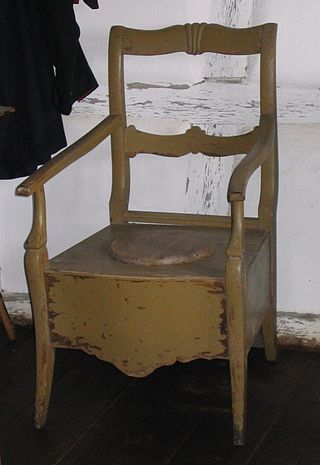
A close stool was an early type of portable toilet, made in the shape of a cabinet or box at sitting height with an opening in the top. The external structure contained a pewter or earthenware chamberpot to receive the user's excrement and urine when they sat on it; this was normally covered (closed) by a folding lid. "Stool" has two relevant meanings: as a type of seat and as human feces. Close stools were used from the Middle Ages until the introduction of the indoor flush toilet.
Italian Rococo interior design refers to interior decoration in Italy during the Rococo period, which went from the early 18th century to around the 1760s.
Thomas Capp or Cappe was a London-based painter and gilder.
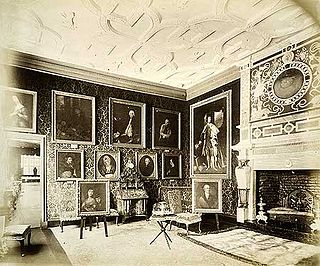
Caffoy was a cut pile woolen velvet material popular for upholstery. It was a decorative textile characterized by its wool pile designs, which were designed to imitate the appearance of silk velvets and damasks. It was originally made from wool and was used to imitate silk furnishing damasks. However, in the 16th century, it may have also been made from silk. Norwich, a major center for worsted weaving, was a major producer of caffoy. In 1579, it was featured alongside other contemporary fabrics such as Darnex, Mockado, and figure-sized Russel in a pageant commemorating the queen's visit to Norwich. Caffoy was` popular during the 17th and early 18th centuries.

Furniture and furnishings in early modern and late medieval Scotland were made locally or imported, mostly from Flanders and France. Although few pieces of furniture survive from the early part of the period, a rich vocabulary and typology is preserved in inventories and wills. This documentary evidence in the Scots language details the homes of the wealthy and aristocratic. Textiles and beds belonging to Mary, Queen of Scots are very well documented. Scottish wooden furniture was often carved with the initials of married couples.
Oliver Browne was a London upholsterer and furniture maker in the 17th century who worked for aristocrats and the royal court. His business partners included John Baker, another upholsterer or "upholder", who worked for the royal family. Baker was "upholster" to James VI and I and Prince Henry, and had supplied items for the coronation of James I and Anne. Baker's son, also John Baker, continued the business after the Restoration.
Ralph Grynder or Grinder was a London-based furniture maker and upholsterer who worked for Charles I of England and Henrietta Maria. He bought and sold art treasures from the Royal Collection in 1651.
















